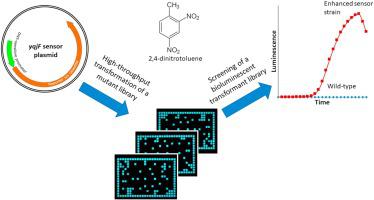当前位置:
X-MOL 学术
›
New Biotechnol.
›
论文详情
Our official English website, www.x-mol.net, welcomes your
feedback! (Note: you will need to create a separate account there.)
Genome-wide gene-deletion screening identifies mutations that significantly enhance explosives vapor detection by a microbial sensor
New Biotechnology ( IF 4.5 ) Pub Date : 2020-11-01 , DOI: 10.1016/j.nbt.2020.06.002 Benjamin Shemer 1 , Etai Shpigel 1 , Anat Glozman 1 , Sharon Yagur-Kroll 1 , Yosssef Kabessa 2 , Aharon J Agranat 2 , Shimshon Belkin 1
New Biotechnology ( IF 4.5 ) Pub Date : 2020-11-01 , DOI: 10.1016/j.nbt.2020.06.002 Benjamin Shemer 1 , Etai Shpigel 1 , Anat Glozman 1 , Sharon Yagur-Kroll 1 , Yosssef Kabessa 2 , Aharon J Agranat 2 , Shimshon Belkin 1
Affiliation

|
Genetically engineered microbial biosensors, capable of detecting traces of explosives residues above buried military ordnance and emitting an optical signal in response, may potentially serve for the standoff detection of buried landmines. A promising candidate for such an application is a previously reported Escherichia coli-based reporter strain that employs the yqjF gene promoter as its sensing element; however, for this sensor to be able to detect actual landmines reliably, it was necessary for its detection sensitivity and signal intensity to be enhanced. In this study, a high-throughput approach was employed to screen the effects of individual gene deletions on yqjF activation by 2,4-dinitrotoluene (DNT). Several genes were identified, the deletion of which elicited a significant enhancement of yqjF induction by DNT. The most promising of these mutations were introduced into the sensor strain, individually or in pairs, yielding a considerable increase in signal intensity and a lowering of the detection threshold. A strain harboring two of the identified mutations, ygdD and eutE, appears to be the most sensitive microbial biosensor currently described for the detection of traces of landmine explosives.
中文翻译:

全基因组基因缺失筛选识别突变,显着增强微生物传感器对爆炸物蒸气的检测
基因工程微生物生物传感器能够检测掩埋军械上方的爆炸物残留痕迹并发出响应的光信号,可能用于掩埋地雷的防区外探测。这种应用的一个有希望的候选者是先前报道的基于大肠杆菌的报告菌株,它采用 yqjF 基因启动子作为其传感元件;然而,为了使这种传感器能够可靠地探测实际地雷,必须提高探测灵敏度和信号强度。在这项研究中,采用高通量方法来筛选单个基因缺失对 2,4-二硝基甲苯 (DNT) 激活 yqjF 的影响。鉴定了几个基因,其缺失引起了 DNT 对 yqjF 诱导的显着增强。将这些突变中最有希望的突变单独或成对地引入传感器菌株,导致信号强度的显着增加和检测阈值的降低。含有两个已识别突变 ygdD 和 eutE 的菌株似乎是目前描述的用于检测地雷爆炸物痕迹的最灵敏的微生物生物传感器。
更新日期:2020-11-01
中文翻译:

全基因组基因缺失筛选识别突变,显着增强微生物传感器对爆炸物蒸气的检测
基因工程微生物生物传感器能够检测掩埋军械上方的爆炸物残留痕迹并发出响应的光信号,可能用于掩埋地雷的防区外探测。这种应用的一个有希望的候选者是先前报道的基于大肠杆菌的报告菌株,它采用 yqjF 基因启动子作为其传感元件;然而,为了使这种传感器能够可靠地探测实际地雷,必须提高探测灵敏度和信号强度。在这项研究中,采用高通量方法来筛选单个基因缺失对 2,4-二硝基甲苯 (DNT) 激活 yqjF 的影响。鉴定了几个基因,其缺失引起了 DNT 对 yqjF 诱导的显着增强。将这些突变中最有希望的突变单独或成对地引入传感器菌株,导致信号强度的显着增加和检测阈值的降低。含有两个已识别突变 ygdD 和 eutE 的菌株似乎是目前描述的用于检测地雷爆炸物痕迹的最灵敏的微生物生物传感器。











































 京公网安备 11010802027423号
京公网安备 11010802027423号